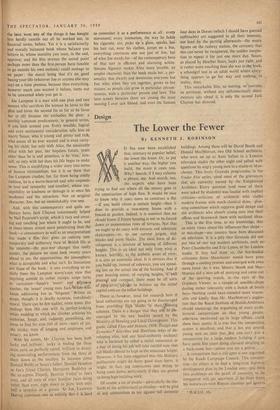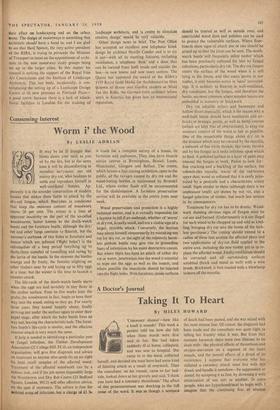Design
The Lower the Fewer
By KENNETH J. ROBINSON
IT has now been established that, contrary to popular belief, the lower the fewer. Or, to put it another way, the higher you build, the more it costs you. Why? Search, if I may exhume a phrase, me. And search, too, the experts who have been trying to find out where all the money goes in the construction of high flats. It would be nice to know why..it costs more to construct a flat —if you build above a certain height—than it does to provide a two-storey house with a fenced-in garden. Indeed, it is essential that we should know if future housing is not to be-forced down to monotonous rows of terraces. Not that we ought to do away with terraces and substitute skyscrapers—or, to use current jargon, slab blocks and point blocks. The ideal, form of de- velopment is. ,a mixture of housing of different heights. This is an ideal not only, from what is known, horribly, ak.the aesthetic point of view;. it is also an economic ideal. It is obvious that if you build up, instead of sideways, you are spend- ing less on the actual site of the building: And if your housing estate, of varying heights,*i§Iwell plannyl.. and compact, there must be all sorts of png-,terma4Irits to balance up the initial capital costs on the tallest buildings.
There' is,: however, need for research here if local authorities are not going to be discouraged from providing' high 'bloCks 'Iti' theirdiiinsing schemes. There is. a'danger that they Offeb6 dis- couraged by the new booklet issued, by the Ministry of Housing and LoCal GovernMent. This guide, called Flats and Houses, 1958: besigh' and Economy,* describes and illustrates ways of de- veloping sites, and any local-authority architect who is harassed by either a soelal conscience or a fear of losing hiS. job Will take carefUI note that tall blocks ShoUld be'kept to'the minimum height. However, it has been suggested that this Ministry publication might do More good than harin; it might, in fact, jog contractors into trying 'to bring costs down, particularly if they are geared to doing high-building work.
Of course, a lot of people—particularly the die- .hards of the architectural'profession—will be glad of any ammunition to use against .tall domestic buildings. Among them will be David Booth and Donald MacMorran, two Old School architects, who were set up as Aunt Sallies in a London television studio the other night and pelted with questions by angry young men in a studio in Man. chester. This lively Granada programme, in the Under Fire series,' aired most of the grievances that are currently nursed by the Enlightened Architect. Every question (and most of them were 'asked by students) was loaded with implied criticism—criticism of architects• whb clothe modern frames with mock-classical skins, plan- ning committees which suppress good design and old architects who absorb young men into their offices and brainwash them with outdated ideas.
This is the first time, to my knowledge, that so many views about.The intluencesIthat shape— or mis-shape—our country have been discussed on television. It is a 'pity that Granada did not put two 'of our top modern architects, such as- PeterChamberlin and Eric Lyons, 'in' the London studio. If they had done so, the hot-headed criticisms from . Manchester would have gone through a cooling'process and emerged with even more force:. As it was, Messrs. Booth and Mac- .Morran did a nice job of parrying and came out of the sparring Match; in .the eyes of - the Ordinary Viewer, 'as a ,couple]of sensible, chaps dealing rather tolerantly with a .bunch of brash boys. Nothing could have sounded more reason- able and kindly than Mr. MacMorran's sugges- tion that the Royal Institute of .Broitish:Architects should encourage the organising of more .archi- tectural competitions so that young people, otherwise swallowed up in large offices, .could show their mettle. It is true that the competition system is excellent,. and, that it has put several young men on .their feet.,,I3ut you .can't win a competition for a large, modern building if you have spent five. years doing classical detailing as a back-room boy—unless you are a genius.., A competition that.is still open is one organised by the Roads Campaign Council. This competi- tion—its object is to find a long-term highway development plan in the London area --will have two Architects. on the panel of assessors, so no competitor will get anywhere if he I AC s.aps. down his motorways with Roman abandon,and ignores * fl.M.S.O., 10s. their effect on landscaping and on the urban scene. The design of motorways is something that architects should have a hand in, and I am glad to see that Basil Spence, the very active president of the RIBA, is trying to persuade the Minister of Transport to insist on the appointment of archi- tects to the new motorway study groups being set up in the larger cities. In this matter his council is seeking the support of the Royal Fine Art Commission and the Institute of Landscape Architects. This last body, incidentally, is con- templating the setting up of a Landscape Design Centre at its new premises in Portland Place— a good move, because there is a lack of educa- tional facilities in London for the training of landscape architects, and 'a centre to stimulate creative design would be very valuable.
Other design news in brief. The Post Office has accepted an excellent new telephone kiosk design by architect Neville Conder and is to try it out—with all its startling features, including ventilation, a telephone 'desk' and a door that can be located from both inside and outside the box—in new towns and new town centres. The Queen has approved the award of the RIBA's 1959 Royal Gold Medal for Architecture to Mies (known to House and Garden readers as Miss) Van der Rohe, the German-born architect whose work in America has given him an international reputation.











































 Previous page
Previous page